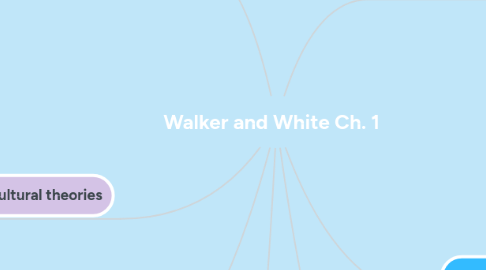
1. Important terms and definitions in learning.
1.1. Vygotsky (1978)
1.1.1. Social-constructivism
1.1.1.1. learning is constructed first through social interaction and then on the individual plane.
1.1.2. Zone of Proximal development (ZPD)
1.1.2.1. difference between what a learner can do without help and what he or she can achieve with guidance from a skilled partner.
1.2. Wood (1976)
1.2.1. Scaffolding
1.2.1.1. collaboration between students allows learning and helps the learner to gain knowledge.
1.3. Krashen (1997)
1.3.1. i+1
1.3.1.1. language learners need to receive input at a higher level than they can produce.
1.4. Lave and Wenger (1991)
1.4.1. Communities of practice (CoP)
1.4.1.1. people engage in shared activity and build community where they can learn from it.
1.5. Gee (2005)
1.5.1. Affinity spaces
1.5.1.1. physical or virtual places where people develop relationships based on shared interests.
2. Social-cultural theories
2.1. learning occurs more effectively when people are working together.
2.1.1. Siemens (2005)
2.1.1.1. Connectivism
2.1.1.1.1. brings together the roles that Taylor created
2.1.1.1.2. learning occurs through engagement with a diversity of ideas and opinions, that knowledge may reside in machines.
2.1.1.1.3. Rhizomatic knowledge
3. Communicative competence.
3.1. Canale and Swain (1980)
3.1.1. Linguistic competence
3.1.1.1. knowing how the language works
3.1.2. Sociolinguistic competence
3.1.2.1. understanding how language is used in context
3.1.3. Discourse competence
3.1.3.1. ability to create and use larger pieces of language to create texts or conversations
3.1.4. Strategic competence
3.1.4.1. repair communication breakdowns and work around unfamiliar areas of language
4. From CALL to TELL
4.1. technology is seen not as assisting language learning, but as part of the enviroment in which language exists and is used.
4.2. TELL includes a wider range of devices than 'computer'.
5. History of CALL
5.1. Warschauer and Kern (2000)
5.1.1. 1st phase: STRUCTURAL CALL
5.1.1.1. based on language as a formal system of structures and focused on drill and practice methods.
5.1.2. 2nd phase: COMMUNICATIVE CALL
5.1.2.1. knowledge of language is constructed in the learner's mind.
5.1.3. 3rd phase: INTEGRATIVE
5.1.3.1. talks about multimedia and the internet as applications that were restrictively tied to desk-based computers.
5.2. Bax (2003)
5.2.1. 1st approach: RESTRICTED CALL
5.2.1.1. types of questions, tasks, responses and feedback tend to be restricted to whatever is programmed into the system.
5.2.2. 2nd approach: OPEN CALL
5.2.2.1. includes open-ended interactions with both computers and occasionally other users.
5.2.3. 3rd approach: INTEGRATED
5.2.3.1. integrated CALL will be only achieved when technology is fully normalized (in teaching).
6. Roles of technology in learning
6.1. Taylor (1980)
6.1.1. computer as a: TUTOR
6.1.1.1. computer teaches the learner, the knowledge resides in the machine
6.1.2. computer as a: TUTEE
6.1.2.1. the learner teaches the computer, language learning through interaction.
6.1.3. computer as a: TOOL
6.1.3.1. no assumption that the computer will teach or learn, use the computer to 'create'.
7. Digital competence
7.1. Procedural competence
7.1.1. ability to manipulate technology in terms of hardware and applications. Knowing how to use the technology.
7.2. Socio-digital competence
7.2.1. understanding what is appropiate to use in different social contexts and knowledge domains in technology and language.
7.3. Digital discourse competence
7.3.1. ability to manage an extended task, using different applications or types of equipment.
7.4. Strategic competence
7.4.1. ability to repair problems and work around the gaps in technological knowlegde and skills.
